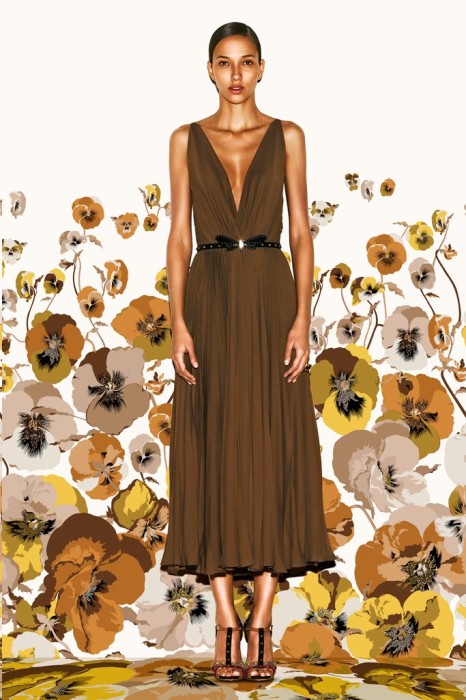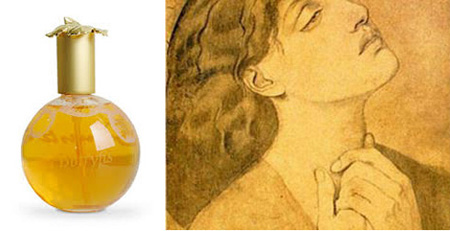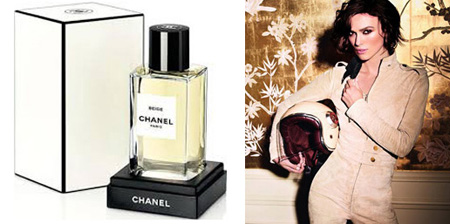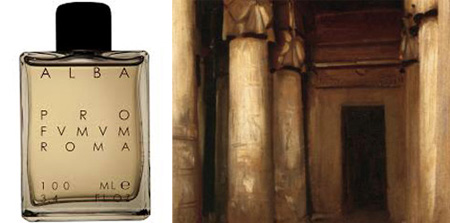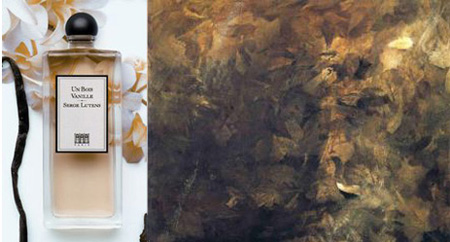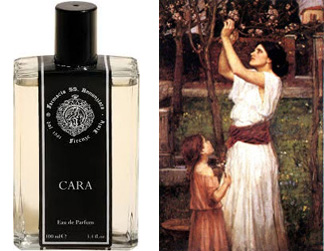Gucci Pre Fall Collection 2012 Model Daniela Alves from style.com
“I wish we could see perfumes as well as smell them. I’m sure they would be quite beautiful.” L.M. Montgomery
While none of us possess the ability to literally "see" fragrances (unless we suffer from clinical synesthesia), we’ve all had the experience of associating color with scent. Fresh scents feel green, aquatic may seem blue, sweet girly scents seem pink, etc. But beige? The first thought that comes to mind may be boring, but think again; while brighter colors get all the buzz, beige comes in an array of hues that are subtle, sophisticated, nuanced, and yes, even sexy. (If you noticed the “nude” gown trend at the Oscars, keep in mind that this is just a fashion copywriter’s way of making the color sound younger.) Far from being boring, beige is brilliant because it starts out as a background for more exotic hues but wins us over with sensory appeal. Join us for a journey through some of its most inspired shades in fragrance and you’ll never think of beige as bland again:
Ginestet Botrytis, Maison Ginestet, Gilles Tolledano, 2008; Study of Guinevere For Sir Lancelot In The Queen's Chamber, Dante Gabriel Rossetti, 1857
Honey Beige: CaFleureBon has recently discussed the contribution of bees to fragrance, but one honeyed fragrance stands out as nectar of the gods: Botrytis, from the French wine company Maison Ginestet, who set out to create a scent as homage to their sweet Sauterne wines. This delicious gourmand combines fruity top notes of plum, quince and apple and base notes of vanilla, sandalwood and white musk with an exquisite spiced golden honey reminiscent of mead, the preferred drink of King Arthur and his knights. The scent has also been described by author Deborah Harkness (of the Discovery of Witches trilogy) as the natural odor of her vampire hero, Matthew. Botrytis positively drips with a sweet, intoxicating sensuality.
Chanel, Les Exclusifs de Chanel Beige, Jacques Polge, 2008; Keira Knightley, Chanel Coco Mademoiselle ad
Chanel Beige: Pantone be damned; Chanel is the only company to have a world-wide recognizable color named after it. As part of the prestige fragrance line Les Exclusifs de Chanel, Beige was created to embody the luxury of the signature Chanel shade familiar to us in their classic quilted purses. Coco Chanel was fond of this color because its apparent simplicity held depths of secrets that unfurled slowly. Jacques Polge has interpreted this idea through a different facet of honey, its creation. The scent opens with the distinct white florals of hawthorn, freesia, linden, and frangipani. The pollen is perceptible, and over time it warms into a sweet, spicy, golden honey. After months of winter starkness, Chanel Beige is a perfectly fertile fragrance for the start of spring.
Profumum Roma Alba, uncredited, 2004; Temple of Denderah, John Singer Sargent, 1891
Ecru: Sandalwood became a prominent ingredient in fragrance not only because it smells good but because of its mystical quality in yoga. True Mysore sandalwood (also called white sandalwood, but its actual color is ecru) is known by the botanical name of santalum album. Profumum Roma’s fragrance Alba, alternately described as meaning Dawn or White, builds on the notion of exploring the calm at the heart of a spiritual practice. With warm notes of sandalwood, hazelnut, almond, and amber (all shades of beige) contrasted with a cool iris, Alba presents the perfect balance between yin and yang and brings to mind a pure, open and airy meditation chamber.
Serge Lutens Un Bois Vanille, Christopher Sheldrake, 2003; Thin Ice, Andrew Wyeth, 1971
Vanilla: Serge Lutens Un Bois Vanille is a fragrance inspired by an ancient enchanted wood, the forestial equivalent of the gingerbread house in the Grimm fairy tale Hansel & Gretel– sweet, but with dark secrets lurking under the surface. This beige delight is as creamy as the finest French glace, flecked with bits of black pod and served in a bowl of exotic woods. Confectionary notes like licorice, coconut milk, caramelized benzoin and bitter almond contrast beautifully with sandalwood and gaiac wood to present a sophisticated, gourmet version of an ice cream sundae.
Farmacia SS. Annunziata dal 1561 Cara, uncredited, 2009; Gathering Almond Blossoms, John William Waterhouse, 1916
Almond: Farmacia SS. Annunziata dal 1561 is an Italian line with a storied past dating back to 16th century Benedictine monks. Cara means dear in Italian, and happy occasions such as weddings in Italy are celebrated with Jordan almonds, colorful pastel candy coating over beige nuts. Cara opens with a breath of fresh, sweet, airy mint green that quickly melts into a delicate, powdery almond and eventually deepens into a mouth-watering caramel. This Viennese table of a fragrance is rich without being overpowering and is one of the most wearable gourmands on the market.
Disclosure: Most reviews were based on samples from the writer’s own collection. Chanel Beige was provided by Chanel for promotional consideration, and Ginestet Botrytis was provided by the monthly subscription sampling service Olfactif for promotional consideration.
–Nancy Knows, Monthly Contributor and editor of the fragrance blog Make Perfume Not War
Thanks to the generosity of the wonderful folks at Luckyscent, we have a draw for samples of Ginestet Botrytis, Profumum Alba, Serge Lutens Un Bois Vanille and Farmacia SS Annunziata Cara for one US reader. To be eligible, please leave a comment on what shade of beige represents you best or which of these scents sound the most appealing to you, and please confirm you live in the USA. Draw closes March 13, 2014
.
We announce the winners on our site and on our Facebook page, so Like Cafleurebon and use our RSS option…or your dream prize wil be just spilled perfume

